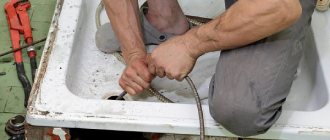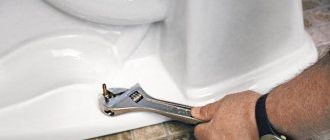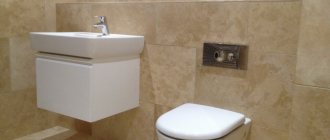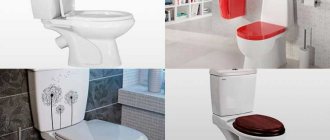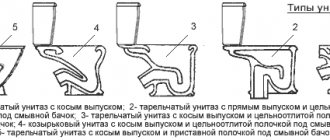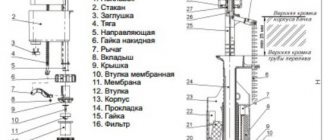Installation of any piece of plumbing requires compliance with installation rules. Many people are wary of this work. Let's look at the installation technology step by step and make sure that you can do it yourself.
In order for the work to be completed without other problems arising, it is necessary to find out the nuances of installing the unit.
Toilet installation algorithm
When installing a toilet, the start is given by assembling the barrel for flushing. The tank is assembled according to the instructions in the instructions.
We take preliminary steps to install water supply and sewer systems.
Choosing methods for attaching the toilet to the floor. This directly depends on the floor covering.
Preparation before installation
First of all, before installing the toilet, you need to take care of purchasing tools. Like materials, they must be of high quality (preferably new). It is better to purchase them from trusted retail outlets. Tools must be manufactured to all reliability standards.
Next, you need to study the design of the purchased product. You need to pay attention to the features of the lower part, which is fixed to the floor. Based on this knowledge, you can make the right decision and choose the appropriate installation method. The toilet mounting should be selected based on the following design features of this product. They include the following features:
- weight and dimensions of the product;
- release direction;
- material of manufacture;
- tank and bowl design.
A common toilet design is where the tank is attached to the back of the product. The bowl is placed against the wall of the room. Fastening elements are bolts included in the delivery kit. In general, the features of fastening to the floor are the same for all types of equipment.
It is important to take into account the material, weight of the product and the design of its lower part. Toilets are most often made from the following materials:
- earthenware - affordable, but fragile, useful life is about 15 years;
- porcelain;
- Reinforced acrylic is strong, durable and lightweight, but does not withstand high temperatures;
- steel is the strongest material, suitable for use in public places.
Useful tips
Plumbing materials, despite their strength, are very fragile. Therefore, maximum force should not be used when securing with screws or bolts. To reduce pressure, softening pads must be placed under the screw heads.
Important! When using glue, you need to thoroughly degrease the surface. If epoxy resin is used for fastening, the proportions of solvent and base substance are strictly observed. The surface is covered with adhesive evenly, without the formation of bubbles.
Instead of wood, you can use high-quality multi-layer plywood as “taffeta”. It is important to ensure high-quality waterproofing so that the lining does not collapse prematurely.
Subtleties of work with different fastening methods
Attaching the toilet to the installation kit (dowel-screw):
- This method assumes that the flooring is in flawless condition.
- The structure after such installation will be consistently strong.
- This installation technology is used for toilets that are small in size and weight.
Landing on cement:
They are called one of the best options for the adhesion strength of materials.
A negative factor is difficult dismantling. Which led to the conclusion of the use of this technology for a toilet with a long service life.
Private method:
- It takes a little more physical effort.
- The aesthetic appearance is pleasing - communications are hidden.
Having prepared all the tools, we begin to work.
Drain device
The attached plumbing fixture is equipped with a special flat tank, which is specially designed for hidden installation. It is installed in a niche, which is made in wall structures to a depth of 10 cm.
The tank, made of high-quality polymer material, is highly durable and has a long service life, which also applies to all its filling. Therefore, situations with adjustments or repairs will not bother you for many years.
A concealed cistern for an attached toilet can be connected to the water supply network from any accessible position along the perimeter of its side surface. The built-in shut-off valve is a prerequisite for its operation.
The drain fittings are connected to the flow activation button by a pneumatic drive or cable. The control, consisting of two buttons, allows for significant water savings. One button initiates the pouring of half the volume of liquid, the other - the remaining part. And equipping with a device that allows you to interrupt the flow by pressing the button again makes it possible to independently regulate the amount of water discharged.
Installation using dowel-screw
Additionally, you may need sealant, a gun for it, or a piece of linoleum.
First, we place the toilet in the place where we plan to install it. If it does not wobble in this place, then the floor is level. It is important. If the structure is shaky, you can lay a piece of linoleum. You need to cut it along the contour of the base of the leg.
Use a pencil to make marks on the floor in the mounting holes. Let's prepare a drill with a drill bit for working on concrete. Working at low speed, we drill the tiles. We are careful so that it does not burst. We drill concrete at high speed. After this procedure there will be a lot of dust.
Remove all debris after using the drill. Use ammonia to degrease areas with holes. Insert dowels into the resulting holes.
We place the toilet in the intended installation location. We check the coincidence of the holes on the floor and on the toilet leg. We lower and twist the bolts for fastening the toilet with a rubber or plastic washer into the dowel.
Lanyard for rigging workCrab system for profile pipes: features of the selection and use of fastening systems and connecting elements
What is a rigging shackle? Size standards, modern types, rules and features of choice
Don't overdo the twisting. The structure may burst.
The last step is to put the decorative caps on the bolt head.
Fastening the structure to the floor using glue
Construction adhesive can be replaced with silicone sealant.
The advantages of this method:
- This installation method will save you from cleaning up dust like after working with a drill.
- The possibility of damaging the floor covering is minimal.
- Ease of installation work. No skills required to work with additional tools.
- This installation option gives confidence in the strength of the toilet’s adhesion to the floor.
Let's look at the advantages and disadvantages
A floor-mounted toilet with a hidden cistern exhibits its undeniable advantages in the following:
- its tank is filled and emptied during the pouring process practically without unnecessary noise, due to the acoustic decoupling through the decorative wall, as well as additional foam inserts;
- it significantly saves space in the toilet, both actually and visually, which is especially important for typical small-sized apartments;
- the interior of the bathroom adds aesthetic appeal;
- does not require an expensive supporting frame for installation, which also simplifies installation activities compared to a suspended installed model.
The weaknesses of the described devices are relative in comparison with other types of plumbing products for similar purposes:
- the cost of attached toilets is noticeably higher than classic floor-standing products;
- if it is necessary to replace the tank or repair communications, there will be inconvenience associated with dismantling the decorative partition;
- Unlike hanging models, they are rigidly fixed to the floor surface, which makes cleaning underneath them difficult, and also does not always meet design requirements.
Installation using cement
- A small recess is made in the floors;
- The toilet is placed in this place;
- The base of the leg is filled with solution.
This option was widespread in the past. A toilet installed with cement can still be found in apartments in old multi-storey buildings. This installation option is reliable and easy to install.
What is a foundation bolt? Tips for choosing a size, application features, marking and classification of fastenersWhy do you need a washer-grower - types of growers, options and application features
Dowel clamp for cable fastening - types, sizes and installation options (100 photos)
Problems arise when it is necessary to replace plumbing fixtures. The only option to remove the toilet is if it is damaged. The second negative point: the installation is not entirely aesthetically pleasing.
Attaching the toilet to the floor using taffeta
- A wooden base with a height of 5 cm is made;
- We make a recess in the floors;
- Fill the hole with concrete solution;
- We hammer nails on the bottom of the substrate;
- Dip the finished substrate into the solution. Fixation occurs in a solution with cement;
- We install the toilet on the resulting pedestal;
- We fix it to the wood with screws.
The toilet room or bathroom has high humidity. Therefore, the wooden substrate must be treated with drying oil or varnish solution.
Suspended installation
The fastening is not made to the floor. The hanging frame is an integral part of the hanging plumbing kit. The metal frame, along with the toilet and flush cistern suspended on it, is hidden behind a plasterboard wall. Only the toilet and the flush button are visible.
Drywall can be tiled. This installation option involves additional financial expenses.
By choosing one of the best mounting options for the toilet, showing patience and accuracy, you can complete the installation perfectly without the help of construction team workers.
Materials used in the production of sanitary ware
Many brands use the same ceramics (porcelain and earthenware) for the manufacture of toilets with hidden tanks as for their other products. However, at the same time, there are products made from composite materials, natural stone or stainless steel.
- Porcelain toilets are durable, resistant to household cleaning agents, do not retain unpleasant odors, and are therefore easy to clean and disinfect.
- Earthenware products are cheaper than porcelain analogues, being a classic representative of products for bathrooms. The material for its production, just like for porcelain, is a mixture of ceramic clays with other mineral additives. However, earthenware firing occurs at lower temperatures. Despite the fact that earthenware toilets are covered with a protective glaze, like earthenware ones, their practicality is somewhat lower - over time, microcracks appear on them, they retain their original whiteness less well.
- Models made of composite materials have a wide range of colors, which is achieved by adding special pigments to the polymer concrete base.
- Toilets with a hidden tank , made of stainless steel, are easy to clean and are the most durable, including shock-resistant. “Stainless steel” prevents the growth of bacteria. Public toilets are often equipped with such plumbing fixtures.
- Models made of natural stone are bright representatives of the elite class, which is confirmed by their highest price. As a rule, they are produced according to special orders for the installation of expensive bathrooms and saunas.
